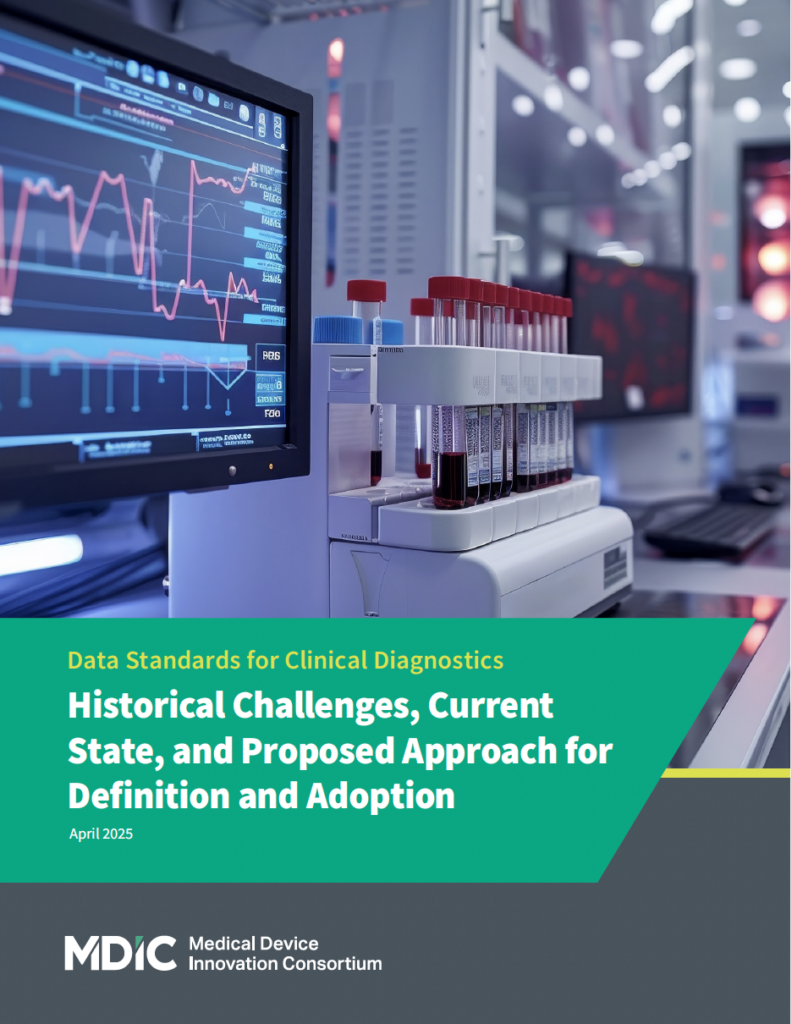Standardizing Clinical Data for In Vitro Diagnostics
Advancing Regulatory Efficiency Through Harmonized In Vitro Diagnostic (IVD) Clinical Study Data

In vitro diagnostics (IVDs) are involved in 66% of clinical decisions in the U.S., yet clinical data submitted for regulatory review of IVDs often lacks consistency and structure, leading to delays in the regulatory process. The Medical Device Innovation Consortium, in collaboration with the regulators and industry, have initiated a Data Standardization Working Group focusing on the creation, promotion, and adoption of in vitro diagnostic clinical study data standards for regulatory submission.
This project introduction explores the historical and current status of clinical study data standard usage for IVDs, while acknowledging the challenges of embracing a single standard across the industry. We explore the flexibility of adopting existing standards to account for in vitro diagnostic-specific requirements and propose strategies to overcome adoption hurdles. By fostering collaboration among stakeholders, this initiative will pave the way for significant improvements in data quality, interoperability, streamlined clinical research, accelerated regulator review and innovation in IVDs. The working group proposes that standards will complement current industry practices to encourage adoption while minimizing disruption.
This paper proposes the development of data standards for IVD clinical studies, leveraging existing CDISC frameworks to reduce regulatory review times and enable faster access to innovative diagnostics.
Whether you’re a regulator, diagnostics manufacturer, data standards expert, or clinical operations leader, this resource offers actionable insights on building an industry-supported pathway toward standardized, high-quality clinical data for diagnostics.
Why Standardize IVD Clinical Study Data?
Currently, there is no unified standard for submitting clinical study or trial data for IVDs. As a result, manufacturers often rely on custom or adapted data formats, leading to inconsistencies in how clinical evidence is collected, reported, and reviewed. These inconsistencies can cause delays in regulatory review, ultimately slowing the approval of life-saving diagnostic tests—delays that become particularly critical during public health emergencies like the COVID-19 pandemic.
The Opportunity:
By aligning with existing CDISC standards—such as CDASH, SDTM, and ADaM—adapted specifically for IVDs, the industry has an opportunity to streamline the submission process. This alignment would reduce delays by creating consistent, high-quality clinical evidence that is easier to interpret and review. In turn, it would enhance data quality, improve traceability, and increase reusability throughout the diagnostic device lifecycle.
What’s Inside the Report
- Background on the Current State of Clinical Data Standardization for IVDs
Learn about the current landscape and regulatory context for IVD submissions, including challenges with non-standardized data and the need for purpose-built frameworks to fill the gap in clinical data for IVDs. - Survey Results from Industry Stakeholders
Discover insights from MDIC’s pre-project survey of manufacturers and clinical teams, revealing strong interest in adoption, key implementation challenges, and areas of potential improvement. - Framework for Adapting CDISC Standards for IVDs
Understand how CDISC’s CDASH, SDTM, and ADaM models can be tailored for diagnostics, including proposed data domains relevant to IVD testing and device tracking. - Collaborative Approach to Industry Adoption
Explore how MDIC is fostering partnerships across industry, regulators, and standard bodies to ensure practical implementation that works across organizations with minimal disruption.
Who Should Use this Resource:
This document is designed to support:
- IVD Manufacturers seeking regulatory clarity and efficiency in clinical study submissions
- Regulatory Affairs Teams navigating FDA and global submission processes
- Clinical Data Managers working to streamline data collection and harmonization
- Quality & Compliance Leaders who manage internal SOPs and audit readiness
- Standards Organizations & Consortia working to align with international frameworks like CDISC
- Healthcare and Public Health Stakeholders focused on accelerating access to reliable diagnostic tests